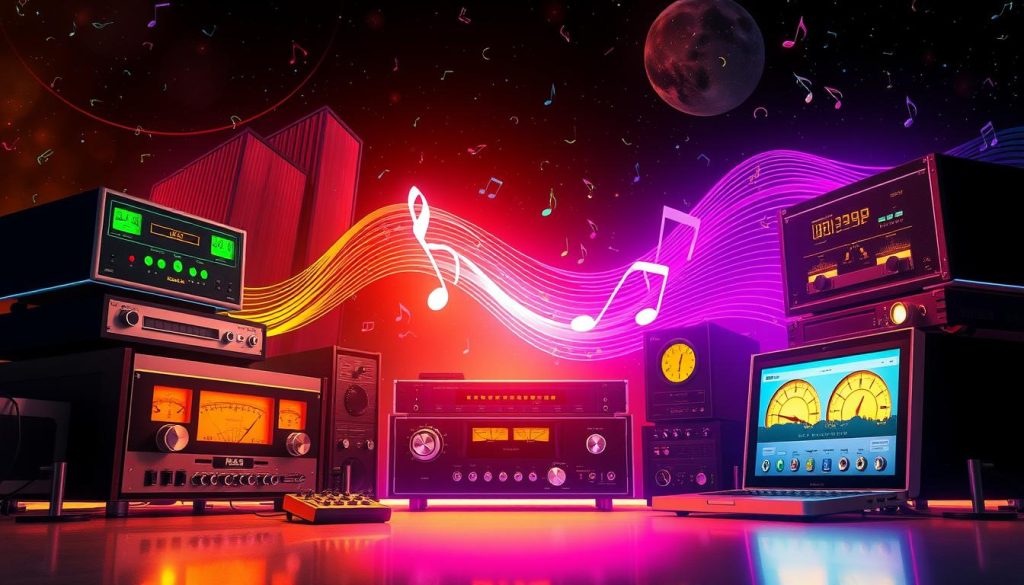The journey of audio technology has been a big change, moving from old phonographs to today’s virtual reality sounds. It has changed how we hear and use sound. This story will take me through the changes in audio technology, changing how I listen in the United States.
The audio industry has changed a lot, making new things possible at every step. It started with early sound reproduction and moved to digital technology. These changes have made listening better, more portable, and connected. This has changed how I listen to music, watch movies, and use technology.
I’m looking into the history and future of audio technology. I’m excited to learn about the innovations that changed the industry. From the first phonograph to today’s wireless audio, each step has made audio technology better. I’m looking forward to seeing how these changes have changed my listening experience.
Pioneering Days: Birthing Sound Reproduction
The story of audio technology started in the late 1800s. Thomas Edison invented the phonograph, a big step in sound reproduction. This device used a stylus to record sound waves on a cylinder.
Soon after, the gramophone came along. It was an improvement over the phonograph. The gramophone used a turntable and needle, making music available to more people. These early steps set the stage for future audio technology advances.
Phonographs and Gramophones: Etching Sound Waves
Thomas Edison created the phonograph in 1877, changing how we hear sound. It recorded sound waves on a cylinder for playback. The gramophone, which came later, used a flat disc instead of a cylinder.
This technology led to the use of vinyl records. These formats became very popular in the music industry for many years.
| Technology | Description | Key Features |
|---|---|---|
| Phonograph | The first device to record and playback sound |
|
| Gramophone | An improved sound reproduction device |
|
These early days in audio technology set the stage for future changes. They led from vinyl records to digital formats.
From Analog to Digital: Embracing the Sonic Revolution

In the late 20th century, a big change came with the digital audio revolution. The Compact Disc (CD) changed everything with its clear sound and ease of carrying around. Digital audio workstations (DAWs) changed music making, letting artists work in new ways.
The CD was a big step forward in audio tech. It offered better sound and was easy to carry, making it a hit with music lovers. It replaced vinyl records and cassette tapes, thanks to its clear and precise sound.
DAWs also changed music making a lot. These software tools gave musicians and producers tools to record, edit, and mix music easily. Moving from old equipment to digital meant more creativity, better accuracy, and faster work.
The digital change touched more than just music. It changed how we listen to music every day. Portable players like the Walkman and the iPod let us enjoy music without being tied down. This led to music streaming, changing how we hear music.
| Analog Audio | Digital Audio |
|---|---|
| Stored on physical media (vinyl, tape) | Stored as digital data on CDs, hard drives, and cloud storage |
| Limited sound quality and dynamic range | Superior sound quality and dynamic range |
| Prone to degradation over time | Lossless and durable digital format |
| Limited editing capabilities | Extensive editing and manipulation capabilities with DAWs |
The switch from analog to digital audio was a big deal. It changed how we make, listen to, and experience music. From the CD to DAWs, tech advances have opened up new ways to be creative and changed the music world.
Audio Technology Advancements: Immersive Experiences

As technology grew, we wanted more from our audio. Surround sound tech made our homes feel like real theaters. Dolby and DTS brought new sounds to movies, music, and games.
Multi-channel audio changed how we enjoyed home entertainment. We moved from two sounds to three dimensions. Surround sound technology made us feel like we were part of the action. It turned our living rooms into movie theaters.
Our wants grew as home entertainment audio got better. We wanted immersive sounds from Dolby and DTS. New tech made sounds come from all around, making movies and music more real.
Now, we keep looking for better surround sound technology. Makers and fans keep finding new ways to make sounds that take us on amazing journeys.
| Feature | Dolby | DTS |
|---|---|---|
| Channels | Up to 7.1 | Up to 7.1 |
| Codec | Dolby Digital, Dolby Atmos | DTS, DTS:X |
| Adoption | Widely used in movies, TV, and home entertainment systems | Widely used in movies, games, and home entertainment systems |
| Immersive Experience | Envelops the listener in a 360-degree soundscape | Immerses the listener in a multi-dimensional audio environment |
Portable Audio: Music on the Move
The Walkman and later the iPod changed how we listen to music. These small devices let us take our favorite songs anywhere. They made music free from wires and changed how we hear music while moving.
Walkman, iPod, and Streaming: Untethering Sound
Sony’s Walkman came out in 1979 and changed everything. It was small and let people listen to music by themselves. Then, Apple’s iPod in 2001 made listening to music digital and easy.
Now, with Spotify and Apple Music, we can listen to anything with just a phone and earbuds. This has made music a big part of our lives. We can listen to songs, podcasts, and more anytime, anywhere.
Portable devices and streaming have made music free from being stuck at home. They let us enjoy music wherever we go. This has made our lives better and changed the music industry a lot.
Wireless Connectivity: Cutting the Cords
The last decade has seen a big change in wireless audio tech. Now, Bluetooth headphones and earbuds are a big part of our daily lives. They give us a smooth, cord-free way to listen to music.
True wireless earbuds have taken this freedom even further. They let us enjoy our favorite tunes or stories without wires. This has changed how we listen to sound, letting us move around and do other things at the same time.
More and more people want wireless audio, so companies have made many options. There are high-end headphones and cheap earbuds for everyone. This means we can all enjoy our music or podcasts easily and without hassle.

